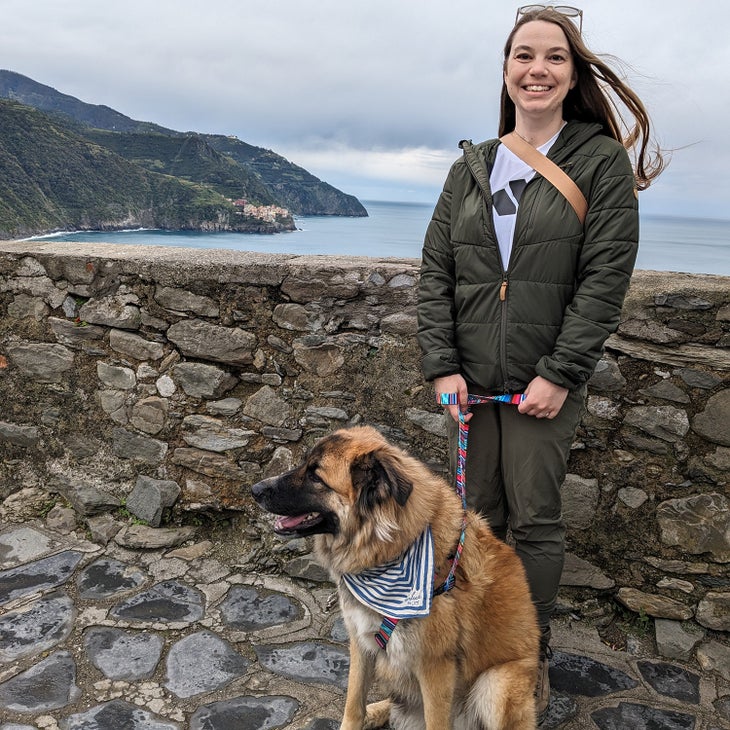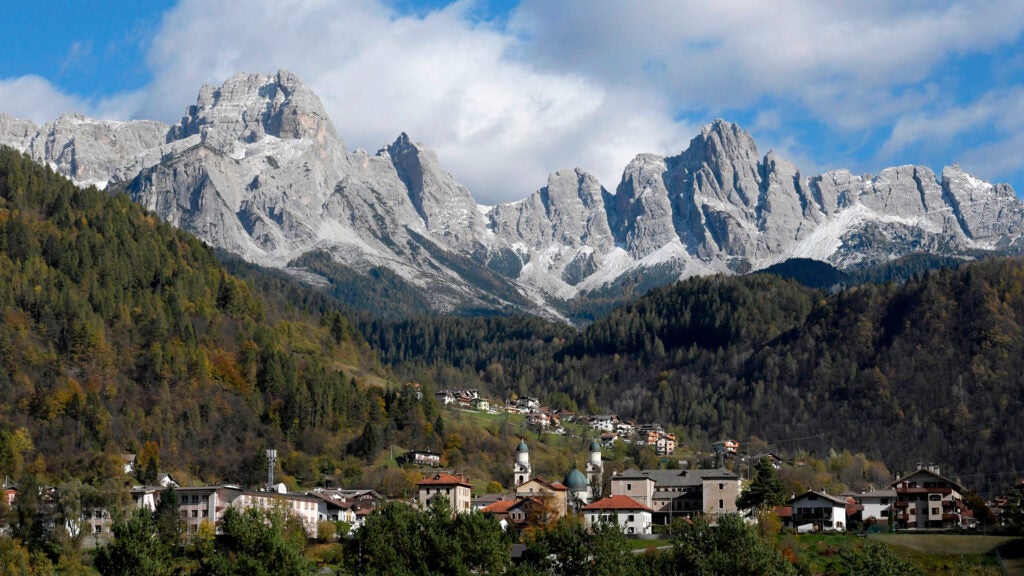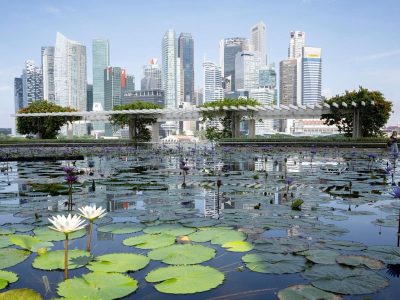When I had the chance to spend some time in Europe this year, the first thing I wanted to do—well, besides find some really good cheese—was figure out how to visit as many national parks as possible. As the editor in chief of National Park Trips, Outside’s sister brand, I spend a lot of time thinking about national parks. Whether it’s figuring out how to pack as much as possible into a weekend in Yellowstone, thinking about the implications of reservation systems, or dreaming about units to visit, I eat, sleep, and breathe America’s best idea.
But narrowing down the European parks to visit proved tougher than I’d imagined. While the 27 EU member countries share a market and (mostly) a currency, each nation’s approach to public lands is vastly different. Some European national parks are all pristine wilderness areas and have strict recreation-use laws. In others, you’ll find trendy bars serving Aperol spritzes, with Vespas parked outside. There’s even a Croatian national park with a zoo, complete with an elephant, ostriches, and zebras. Slovenia has just a single park; Finland has dozens.
While European parks run the gamut, they all have one thing in common. They’ve been set aside as meriting designation, meaning they’re worth a visit to see something meaningful, whether that’s glistening glaciers, spectacular mountain peaks, hanging bridges across thundering rivers, or ancient vineyards clinging to cliffs above the sea.
These are the European national parks that top my travel bucket list. I’ve been to several of them and can’t wait to see the rest.
1. Triglav National Park, Slovenia (Triglavski Narodni Park)
Admission: Free

WHY GO: While Alpine countries like France and Austria get most of the love, many people know almost nothing of one of the Alps’ best destinations: Slovenia. On my first visit to the country I was instantly charmed by the country’s rolling pastures, pretty churches set against the backdrop of mountains and blue lakes, and university-town capital, Ljubljana, which, with its avant-garde metalwork and dragon mascot, has a decidedly punk feel. When I realized that a subrange of the Alps was protected in the northwestern corner of the country as Triglav National Park, I knew I had to return.
Nestled up against the Italian border and nearly touching Austria, Triglav is home to thick forests, rivers, mountain villages, and big peaks that quickly made it one of my favorite national parks. Mount Triglav is the crown jewel at 9,396 feet, but plenty of other impressive summits draw peak baggers from across the world. Vogel Ski Resort can be found here too, offering 14 miles of terrain.
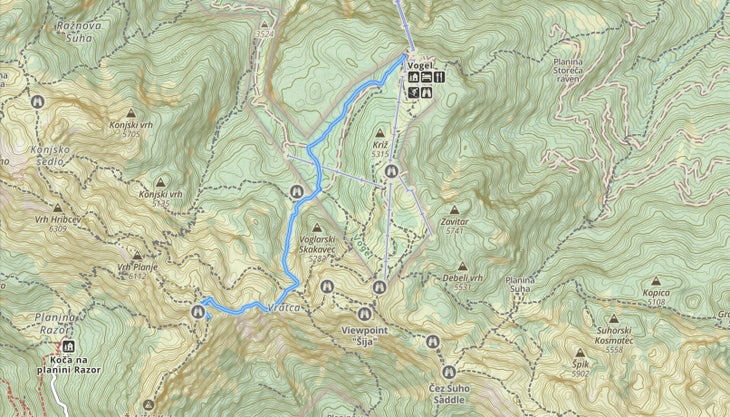
BEST ADVENTURES: Most park visitors flock to the Lake Bohinj region, a nearly 800-acre glacially carved valley filled with deep blue water where you can rent traditional wooden rowboats ($16/hour), among other watercraft. Vogel is in this area, and you can take the gondola and chairlift ($34 roundtrip for adults) partway and hike to the summit. The 6.1-mile Vogel Summit trail isn’t technical, but it is steep in places, secured with cables and pegs. Keep your eyes peeled for the ibex and chamois that live here.
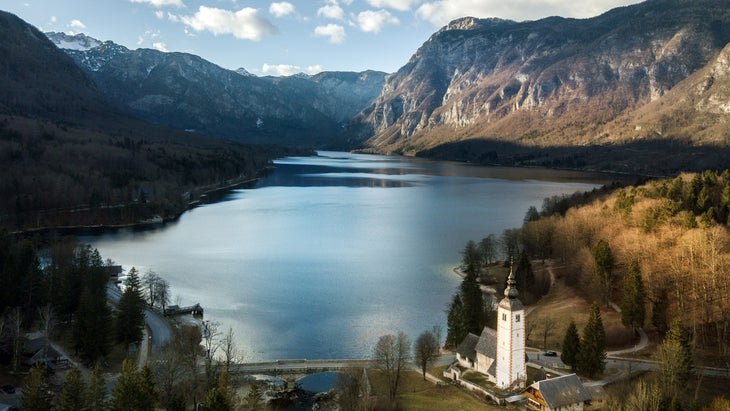
Watch the weather for wind gusts that could shut down the lifts, and stay aware of the time, because it’s a long trek back down if the chairs stop running before you reach them (they close at 4 p.m. in the summer). At several traditional huts on the mountain, you can enjoy local cheese and mountain dishes like goulash.
While the Bohinj area is the most popular, venturing further into the park is absolutely worth it. Head up and over the steep and narrow Vršič Pass to Triglav’s more remote west side (my favorite), where you’re as likely to encounter a herd of sheep blocking the road as cyclists riding on it. Tackle the 15-mile Soča River Trail, a hike that can be done in a long day, or at a slower pace, where you spend the night in one of several villages along the way. The beautiful trail follows the river, which is so clear and bright it almost hurts to look at. My husband, dog and I got distracted on our hike and instead spent a pleasant afternoon wading in the cold snowmelt. Wind your way gradually down valley under larches and across swinging bridges.

If you really want to get away, several long-distance trails, including the Via Alpina red route (1,500 miles) and the Alpe Adria Trail (466 miles), run through Triglav. For less of a commitment than those, head into the Seven Lakes Valley on a multi-day excursion, where you can spend the night in several maintained huts (no camping is allowed in the backcountry).
HOW TO GET THERE: Slovenia has a great public transportation system, making it easy to get from Ljubljana to Bled by train (40 minutes) and then Bled to Bohinj by bus (40 minutes), so you can stay in the capital and still explore the park. Buses run to other parts of Triglav, too, but pay attention to timetables, as they are less frequent and getting a taxi or rideshare won’t be an option in remote parts of the park.
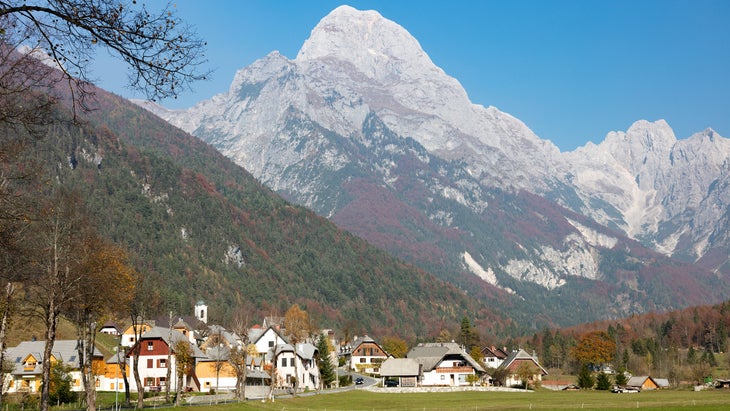
BEST TIME TO GO: June to September is high season for hiking and hut availability, but can also be crowded. Snow melts early in this part of the world, so low elevation hikes can be done in the spring and fall to avoid the crowds.
WHERE TO STAY: Accommodations, from private hotels and guest houses to campgrounds and mountain huts, abound inside the park. My husband and I like staying in Bohinj on the west side for easy access to Vogel and the pretty town of Bled, or the quiet village of Trenta on the east side. For an alpine experience, book a bed at Tičarjev Dom ($47 per person with breakfast), the mountain hut at the summit of Vršič Pass. You’ll sleep dormitory-style and rise to incredible mountain views the next morning from the patio over a bela kava (coffee with milk).
2. Oulanka National Park, Finland
Admission: Free
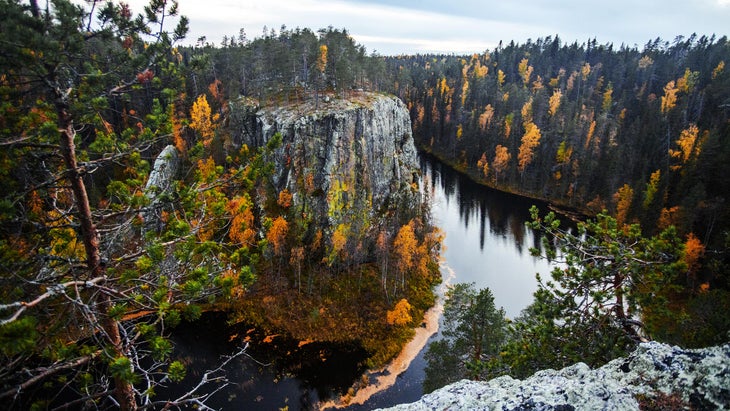
WHY GO: If you’re looking to get into some of the most remote wilderness on the continent, head to Oulanka National Park in Finland. The park hugs the Russian border in the far northeastern part of the country above the Arctic Circle and is an experience in solitude. In fact, the wilderness doesn’t stop at state lines. It continues east, bleeding quietly into Russia’s Paanajärvi National Park, with a simple rope forming the border and keeping canoeists in the EU. Last year I visited Levi Ski Resort in Finnish Lapland, four hours to the north, and fell in love with polar night. Getting back is at the top of my list and this time I want to get deeper into the wilderness, specifically at Oulanka.
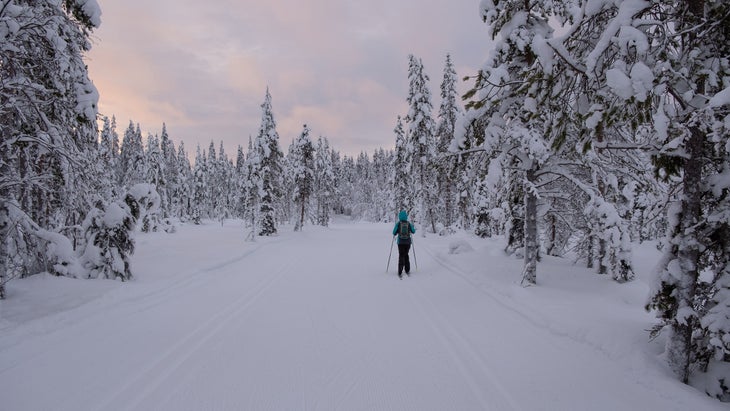
Planning a trip to this remote land filled with boreal forests, rushing rivers, and limestone gorges isn’t easy, but I promise the hardest part will be picking which season to visit–winter or summer? This far north, the year is capped by eternal night in the deep winter, when you can snowshoe, cross-country ski, and try to spot the Northern Lights, and permanent sun in the height of the warm months, with plenty of daylight for canoeing and hiking trips.
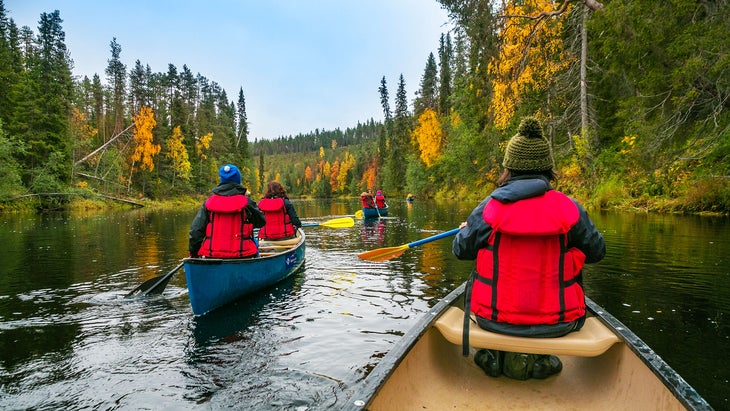
BEST ADVENTURES: Summer visitors have two main choices for exploring: by water or by land. Paddlers can rent canoes and camping gear from Oulangan Taika to embark on a trip down the Oulankajoki River. The lower section is calm, with a short two-hour option to a takeout or a seven-hour route that makes an excellent overnight trip with a stop at any of several campsites or the first-come, first-served Ansakämppä Wilderness Hut. There are rapids and a portage on the upper section of the river, so skip it unless you’re an experienced boater.

On foot, try the 7.1-mile Pieni Karhunkierros Trail, a loop that crosses some of the park’s famous hanging bridges. In summer months, the trail is one-way (clockwise). Backpackers can head out on the 50-mile Bear’s Ring, aka Karhunkierros Trail. Finland’s most popular hike traverses the park from north to south, with each stage ending on a bus route in case you’d prefer to sleep in a real bed, or campsites and huts along the way if you’d rather rough it. Thundering rivers, placid streams, bogs, hanging bridges, and delicate purple orchids await. Look out for traditional Sami herders and their reindeer, who still inhabit the area today.
In the winter, I love how the mercury plunges when Finnish Lapland freezes over, rewarding intrepid and cold-tolerant visitors with a magical landscape. It’s my favorite time of year to be in Finland. Pines and spruces thick with frozen snow stand like fuzzy sentinels over ice-crusted rivers and cross-country ski trails. In December and January, you’ll find a scant three hours of daylight. In late winter, you’ll still experience plenty of darkness for northern lights spotting, but will also be treated to long sunrises and sunsets, turning the landscape into a cotton-candy-colored forest.
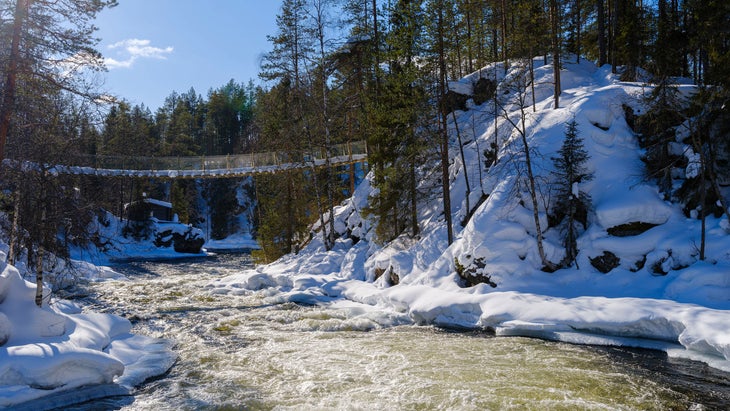
Use an app like My Aurora Forecast to monitor northern-lights conditions for your best chance at spotting the undulating colors. Other winter options are to rent snowshoes or cross-country skis in nearby Ruka and set off on the park’s many trails.
HOW TO GET THERE: The closest airport to the park is Kuusamo, which has several flights from Helsinki each day, plus a few other major European cities like Brussels and Frankfurt. While renting a car in Kuusamo is the easiest mode of travel, a bus route from the airport accesses the Karhunkierros Trail, Oulanka National Park Visitor Center, and Ruka, if you’re eager to add downhill skiing to your itinerary. Ruka Ski Resort is Finland’s best known, and has a long season lasting October to May.
BEST TIME TO GO: Peak season for hiking and canoeing, the park’s main attractions, is July through September when the weather is warmest and most predictable (think 50s) and the days are the longest. To see the Northern Lights and get out on snowy trails, December through March are the best season, but be ready for temps from freezing to below zero.
WHERE TO STAY: For the most options, base yourself at Ruka Ski Resort. Ruka offers all sorts of lodging options and the park is a quick 30-minute drive away. Winter visitors who want to go all out should stay at Magical Pond, with glass igloos perfect for aurora spotting (from $347/night with breakfast). If you want to be closer to the park, Oulanka Basecamp’s cozy wilderness hotel borders it (from $109/night for a double room).
3. Cinque Terre National Park, Italy (Parco Nazionale delle Cinque Terre)
Admission: $21-$35/day for train and trail access
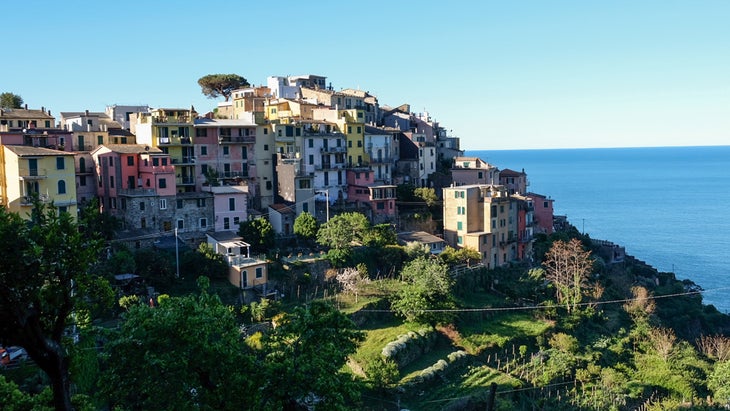
WHY GO: I’d seen the brightly colored Italian houses clinging to cliffs above an azure sea on my Instagram feed, but had no idea that the five villages making up the Cinque Terre (note the article “the,” as you’ll be judged mightily for dropping it) are actually a national park until I visited this past spring. The land here is characterized by its human influence. The steep hills leading straight into the sea have been terraced and cultivated for more than 1,000 years.
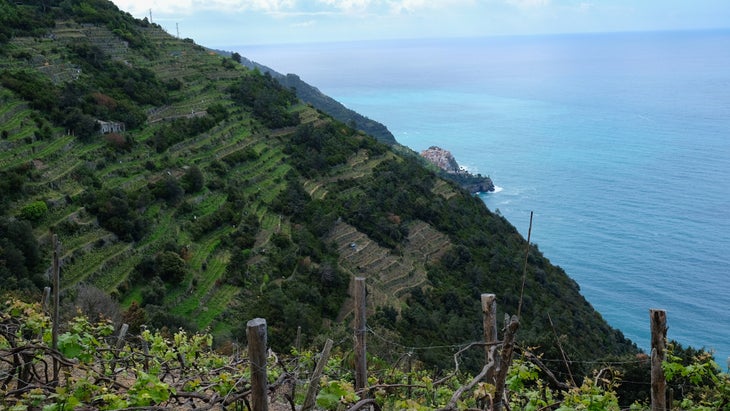
BEST ADVENTURES: The most popular hiking route is the Blue Trail (also called the Sentiero Azzuro or SVA), the main path that historically connected all five villages. In 2019, a landslide took out the section of trail between Corniglia, Manarola, and Riomaggiore, and maintenance work is ongoing, though the Manarola to Riomaggiore section reopened in July. The sections between Corniglia, Vernazza, and Monterosso al Mare remained open. Whenever you choose to travel, start out as early in the day as possible or plan an evening hike to dinner to avoid the crowded midday hours. Taking the train back is also always an option if the trails get packed (we had to turn around and take the train in April because the pathway was gridlocked).
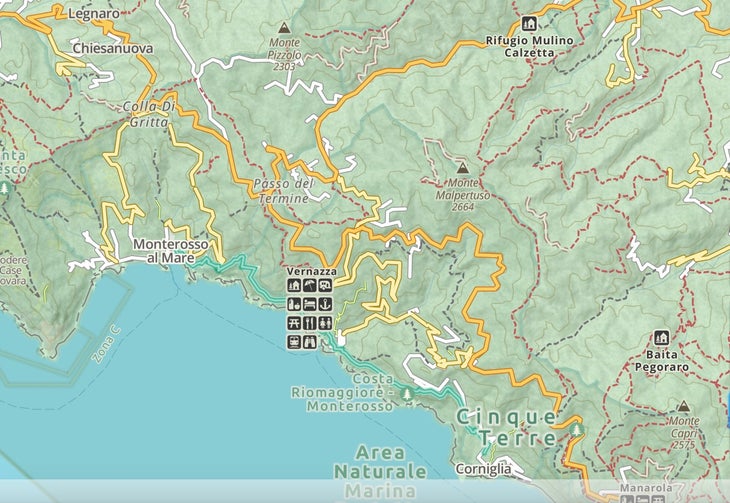
The section of the Blue Trail from Corniglia to Vernazza (grab a focaccia made with the region’s famous pesto for my favorite mid-hike snack) and on to Monterosso is 4.1 miles one way with 2,000 feet of elevation gain. A less popular, but in my opinion even better, hike on the Blue Trail is the high route between Corniglia and Manarola. You’ll climb up to the tiny town of Volastra, perched above the Cinque Terre, and then back down to Manarola. Time your hike so that you can grab a glass of wine and bruschetta at Cantina Capellini, a winery producing the Cinque Terre DOP white wine. The simple patio is right on the trail, situated amongst the vines, and overlooks the sea. Make sure you have room in your pack for a bottle to take home.
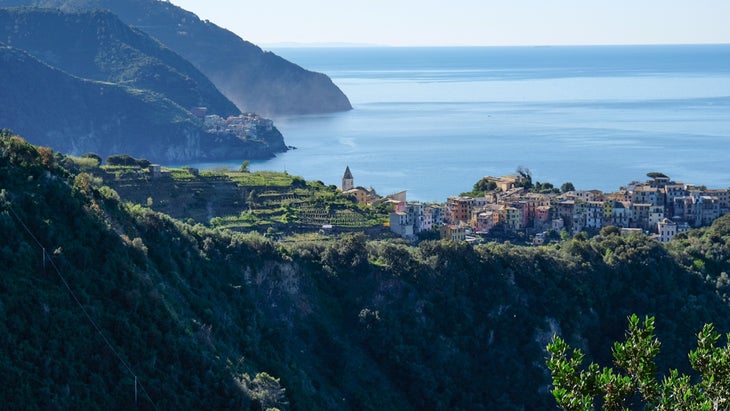
Heading south from Corniglia and ending in Manarola is 3.6 miles one way, with 1,300 feet of elevation gain. The descent on this route is heinous (you’ll end lower than you began), so you may want to skip this one if your knees are bad.
When you’re not on the trail, take advantage of amazing food (cornettos! pesto! wine! fried anchovies! focaccia!) on a patio, or head down to the water. Each town has sea access for swimming, though you won’t find much of a beach anywhere besides at Monterosso. Spread a towel on the rocks and sunbathe, or rent a kayak ($10.75/hour rentals from Riomaggiore) to explore the coastline.
HOW TO GET THERE: Fly into Florence, Milan, or Rome. Trains run directly from these major hubs to La Spezia Centrale, the closest city to the Cinque Terre, or you can drive to La Spezia Centrale and park your rental car in the large garage at the station. From there, it’s a quick seven-minute train ride to the first village, Riomaggiore. Each additional village is just a few minutes further up the tracks. If you plan on utilizing both the train and the trails, purchase a Cinque Terre card in advance, which allows unlimited train rides between villages (including La Spezia), access to the trails, and free use of the toilets at each train station ($21-$35/day).
BEST TIME TO GO: Hiking the Cinque Terre is best done in the off-season. Summer crowds are epic, and the trails can get packed by late morning even in the spring and fall.
While it’s a gamble to visit in the colder months (November through March), as the trails can close when weather is bad and you’ll have fewer lodging and dining options, it’s the least busy season. Plan a visit for the fringe months of March or November to capitalize on good weather and to beat the masses.

WHERE TO STAY: You’ll find hotels in Monterosso and Riomaggiore on each end, as well as in the larger city of La Spezia, a quick train ride away. But for the most authentic experience stay in one of the three central villages. Book a vacation rental (Airbnb has plenty of options) in Vernazza, Corniglia, or Manarola, and you’ll get to experience the towns when all the day tourists from the cruise ships have left. Quiet restaurants, empty streets, and coffee with the locals each morning are treats.
My favorite village is Corniglia, for its smaller size and gorgeous view from atop a hill, though the walk from the train station up a long set of stairs to the town makes coming and going a chore. We ended up skipping our dinner reservations one town over in favor of staying put here with a bottle of wine and take-out focaccia.
4. Dolomiti Bellunesi National Park, Italy (Parco Nazionale Dolomiti Bellunesi)
Admission: Free

WHY GO: While each region of Europe’s Alps has its own flavor, the Italian Dolomiti are particularly impressive. Craggy mountains, mist-filled valleys, and sweeping forests provide one of my favorite landscapes in the world.
The range, which encompasses northeastern Italy, is home to the 12 world-renowned ski areas that make up the Ikon Pass destination Dolomiti Superski. It’s also a Unesco World Heritage Site and the location of several incredible regional parks, such as Tre Cime. But you’ll only find one national park, Dolomiti Bellunesi, in the region. I’ve somehow missed this corner of the Dolomiti in all of my adventures here, so I can’t wait to plan a trip back to see it.
Stretching 12-square-miles northwest of Belluno, this somewhat under-the-radar park offers visitors the best of the Dolomiti, with fewer crowds than the area’s better-known and more northerly destinations of Tre Cime, Seceda, and Lago di Braises. Home to via ferratas, two of the famous Alta Via trails, and countless quintessential Italian villages, this is the place where you want to start your Dolomiti adventure.
BEST ADVENTURES: You’ll want to experience this national park by foot–miles of trails cross the mountains, including two of the Alta Via, or “high routes.” Alta Via 1 is a classic and one of the least technical of the routes, running 75 miles from Lago di Braies to La Pissa. The final four stages, which are often the least crowded, wind through the park. Alta Via 2 also includes three stages in the national park, from Passo Cereda to Passo Croce d’Aune. This route is more technical, with via ferratas required along the way. A climbing harness, helmet, and gloves are needed to tackle this option (rent them in Cortina d’Ampezzo for $23/day).
Whether or not you embark on one of the park’s through-hikes, you should definitely experience a via ferrata while in the Dolomiti. Popularized during WWI in the region to help troops navigate vertical terrain, these “iron paths” use ladders, rungs, pegs and steel cables affixed to rocks to help people move across the cliffs. The park’s highest peak, Schiara, has three via ferratas ringing it: Zacchi, Berti, and Piero Rossi, which, linked up, make for a long but doable day in the mountains if you stay at Rifugio Settimo Alpini ($74/night for half board). These routes lean toward being difficult, so hiring a guide is advisable. I found Cortina Mountain Guides to be excellent on my most recent via ferrata adventure, on the Punto Anna route in Cortina d’Ampezzo, an hour and a half north.
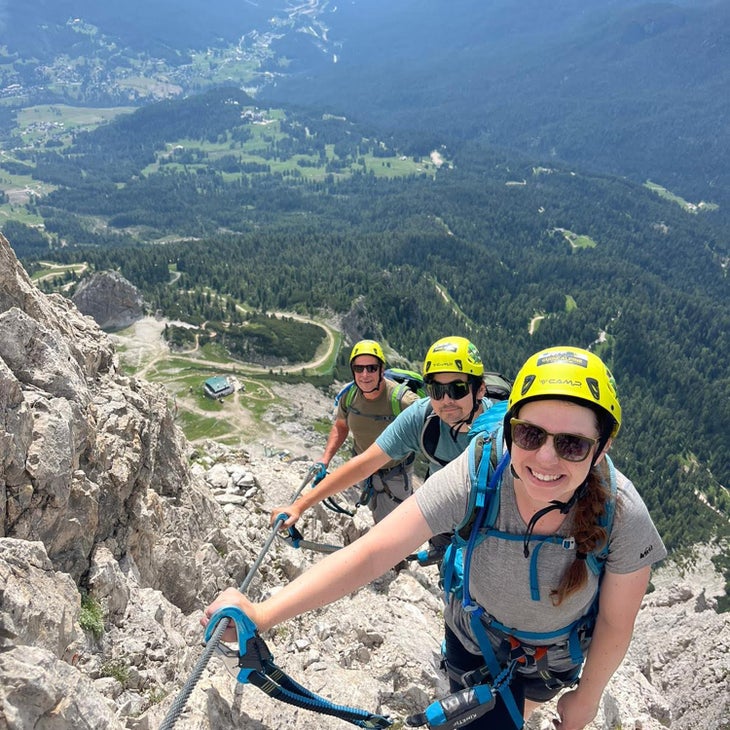
Cyclists can test their mettle on the grueling stage 20 of the 2022 Giro d’Italia route, which runs 104 miles (168 kilometers) from Belluno to Marmolada, crossing through the park on SR203. Whatever activities you choose to get up to, make sure to include some time on either end of your trip for a quick detour to the so-called Prosecco Road between Valdobbiadene and Conegliano, where the prestigious DOCG (the highest quality designation) sparkling wine is produced in the hills. My favorite producer, Adami, is one of the oldest in the region and has an excellent tour and tasting experience.
HOW TO GET THERE: Venice offers the closest major airport, and train service to Belluno takes approximately two hours. From there, the Dolomiti bus services many of the roads within the park, but note timetables, as service can be limited. Unless you’re planning a through-hike, the best way to explore the Dolomiti is by renting a car in Venice or Belluno, then driving to trailheads.
BEST TIME TO GO: Most staffed rifugios (mountain huts) away from the ski resorts are only open to hikers in summer, so June through September are the best months to visit if you’re planning an overnight adventure. The weather often stays pleasant through October, though, and travel then is a great way to skip out on some of the crowds if you’re prepared for the possibility of an early season snow storm.

WHERE TO STAY: Hiking the Alta Vias, even just a few linked stages, takes forethought, as many of the rifugios along the route fill up early in summer. Start planning in January or February when availability opens. Otherwise, you’ll find accommodation options—including hotels, guesthouses, rifugios, and vacation rentals—in and around the park, but book early as options can be limited. Belluno, with 36,000 inhabitants, is the closest major town.
For a unique experience, plan a stay at an agriturismo, a working farm where you’ll be treated to meals with homemade products like cheese and salumi. Mountain pasture cheesemaking has become a somewhat lost art in the Dolomiti, but this park has worked hard to restore five of these “malga” operations. If you don’t stop at an agriturismo, watch for latterias (like Latteria Perenzin in San Pietro di Feletto) where you can buy the locally made cheese alongside salumi and other products perfect for a picnic.
5. Samaria National Park, Greece
Admission $5.50
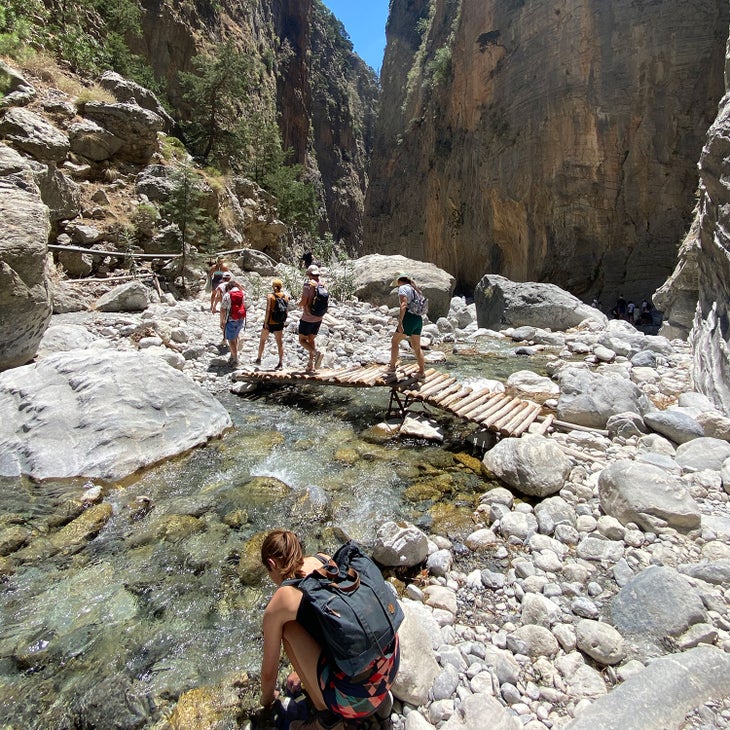
WHY GO: Encompassing the longest gorge in Europe, Samaria National Park showcases the best of the Mediterranean, from towering cliffs to fragrant cypress trees, and from white limestone riverbeds to the sparkling sea itself. Since the park is comprised almost solely of one long, steep 8 to 9.5-mile hike, you can experience the place in its entirety, from the White Mountains to the Mediterranean, in one day. Samaria Gorge is located on the western side of Crete, Greece’s biggest island. I haven’t gotten to Greece yet, but a friend and colleague promises me that it’s the first place I’ll want to go.

BEST ADVENTURES: The park is open, weather permitting, from May through October. Entry begins at 7 a.m., and it’s an excellent idea to start out then, before the heat of the day. Much of the trail is exposed and sunbaked, so going the first or last month of the season is wise to avoid the mid-summer heat. The park closes down during excessively hot stretches, or if flooding is possible in the shoulder season. Pay attention to the heat and hold off if the temperatures are dangerous. It’s usually a five- to seven-hour hike without services, so pack plenty of water and snacks; bring sun protection, a hat and a neck gaiter to help stay cool; and wear hiking footwear. Water from springs is often available along the route, but don’t count on it.
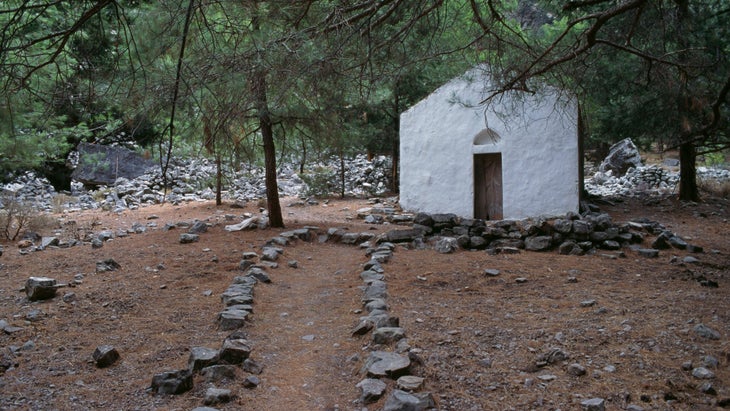
You’ll start hiking steeply downhill, taking in the views of the surrounding White Mountains, before continuing through a pine and cypress forest and reaching the church of St. Nikolas inside the ruins of an ancient temple. Look around for kri kri, wild Cretan goats. Cross a few streams and you’ll find yourself in the ancient village of Samaria, which is now solely inhabited by park staff.
The gorge gradually narrows as you cross through a (hopefully) dry riverbed, alongside striped rock walls, into the skinniest point in the canyon, where the walls are just under 10 feet apart. The park closes at 6 p.m., so make sure you’re through the exit by then. Either walk another 1.5 miles or hop on a cheap shuttle to get to the village of Agia Rouméli, where you can grab a late lunch or early dinner at one of several restaurants and, if time allows, take a well-earned dip in the Mediterranean.
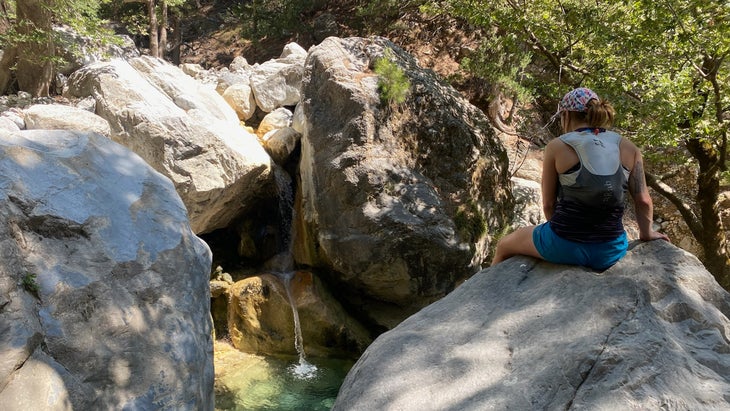
The single ferry leaves the village at 5:30 p.m., only once per day, so don’t miss it or you’ll have to arrange a taxi boat or stay in the village. Depart at Chora Sfakion or Sougia and take the bus back to your car or lodge. If arranging your own transportation stresses you out, many tour companies offer guided excursions in the park.
HOW TO GET THERE: From Athens, fly into Chania International Airport for the closest access to the park. In Chania, you can either rent a car and drive to the gorge, or purchase a bus ticket to Xyloscalo, at the start of the trail. The full hike is one way, and at the end you’ll take a ferry to Sougia ($16/person) and then the bus either back to your car at the trailhead or your hotel in Chania. Be sure to reserve your return tickets in advance to avoid getting stranded.
BEST TIME TO GO: Samaria Gorge is open May through October, with the beginning and end of the season providing the coolest temperatures.
WHERE TO STAY: Most visitors base in the city of Chania and do the trip to Samaria Gorge in one long day, but if you, like me, would prefer a slower pace and to experience the secluded village of Agia Rouméli without the crowds, you can stay at one of the few hotels or vacation rentals in town. Agia Rouméli Hotel offers rooms, breakfast and beach loungers starting at $79 per night. You can spend the entire next day enjoying the beach before catching the ferry back.
6. Écrins National Park, France (Parc National des Écrins)
ADMISSION: Free
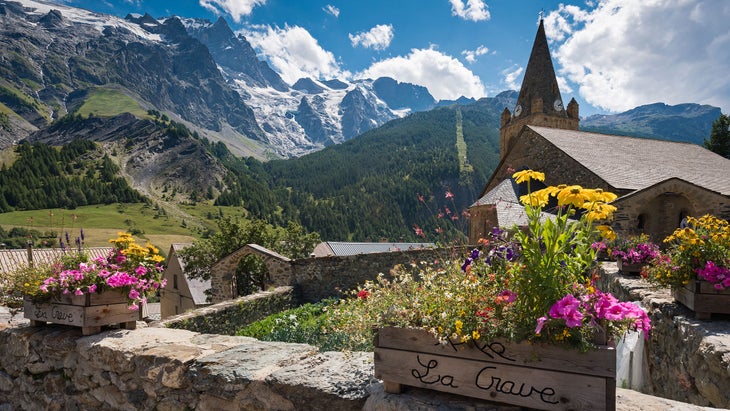
WHY GO: Écrins National Park, a glacier-filled alpine paradise with more than 150 peaks topping 3,000 meters, sits near the Italian border in eastern France. The Alps are one of my favorite landscapes in the world and, after visiting them in Austria, Italy, Slovenia, Switzerland, and Lichtenstein, I put this French national park squarely on my to-do list. Barre des Écrins is the tallest summit here, towering 13,458 feet above the park, the most southerly 4,000-meter peak in the Alps. Here, amongst the chamois you’ll almost certainly spot, you’ll feel like you’re at the top of the world.
BEST ADVENTURES: You could hike the park’s many trails, including a section of the Grand Écrins, but this is also a space known for its alpine climbing. If you’re looking for adventure, a three-day mountaineering- and glacier-skills course with Undiscovered Mountains will help you tag the summit of Barre des Écrins, staying in remote mountain huts ($1,645).
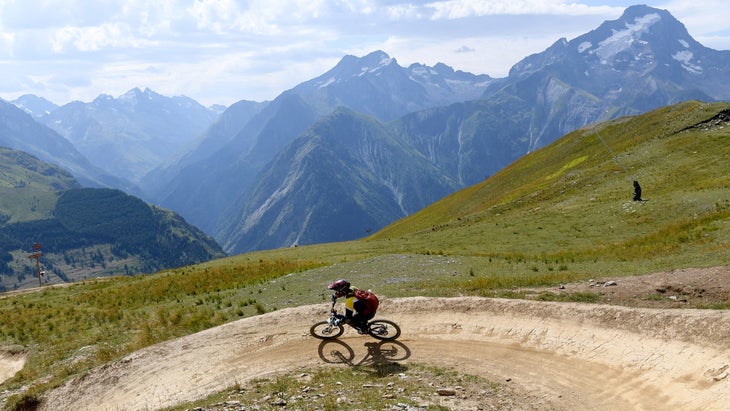
Within the boundaries of Écrins are two ski areas, and two others just bordering the park might be the area’s most famous, especially for cyclists. Les Deux Alpes bike park is one of the biggest in the Alps and is home to beginner- to competition-level courses in everything from downhill to enduro with pristine alpine views. Alpe d’Huez offers one of the Tour de France’s most iconic climbs in addition to the wild Megavalanche, a mass-start mountain-bike race on a glacier. Ride into the national park, which has around 100 miles of marked bike trails.
HOW TO GET THERE: The closest major city is Grenoble, France. Fly into Lyon, Geneva, Marseille, or even Paris and take a high-speed train to Grenoble. From there, if you plan on some serious exploring, it’s best to rent a car, but bus service is also available to Les Deux Alpes if you will stick to the resorts or hire a guide to get into the mountains.
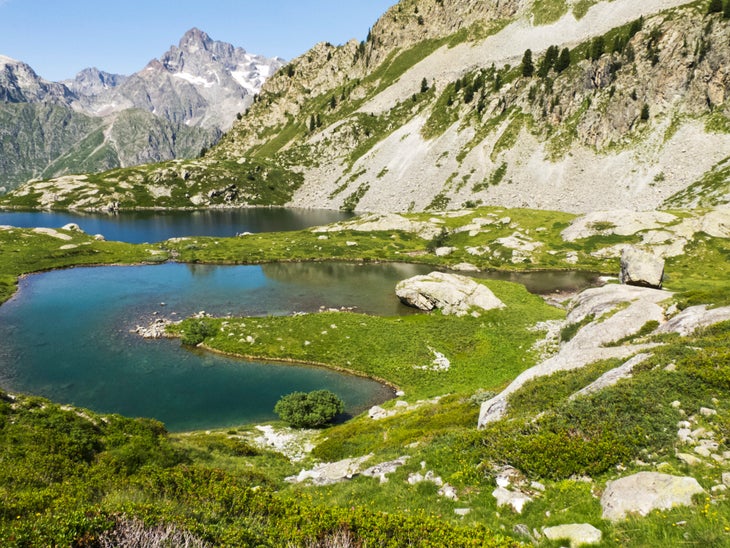
BEST TIME TO GO: July through September are the months to visit to avoid snow in this mountain environment.
WHERE TO STAY: The ski resorts and villages in and around Écrins provide ample lodging, but to really get away from it all, book a stay in one of the 40 refuges throughout the park. While some of these mountain huts simply serve as basic overnight shelters for mountaineers, others are staffed in the summer, offering hot dinner and breakfast and often a lovely patio on which to take in the setting sun in a gorgeous high-alpine setting.
Refuges almost always require a hike to reach, so choose your trail, do your research and book ahead to ensure you have a bed waiting at the end of your day.
Mikaela Ruland is the editor in chief of National Park Trips. She lives for the outdoors, and you can usually find her hiking, skiing, or mountain biking. She’s been to national parks on three continents, including 23 of the 63 U.S. national parks. Her favorite is whichever one she’s traveling to next.
